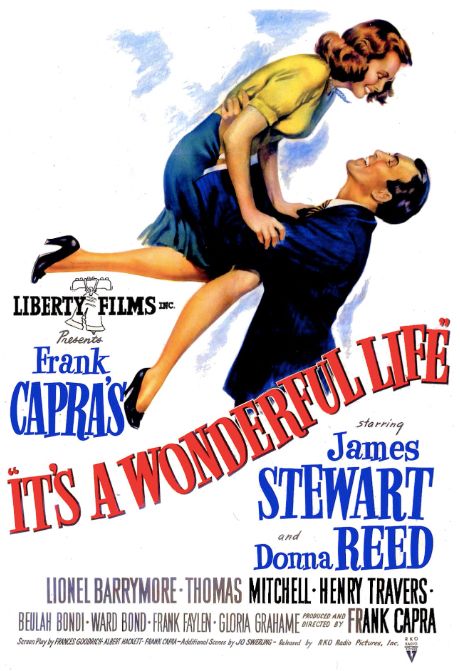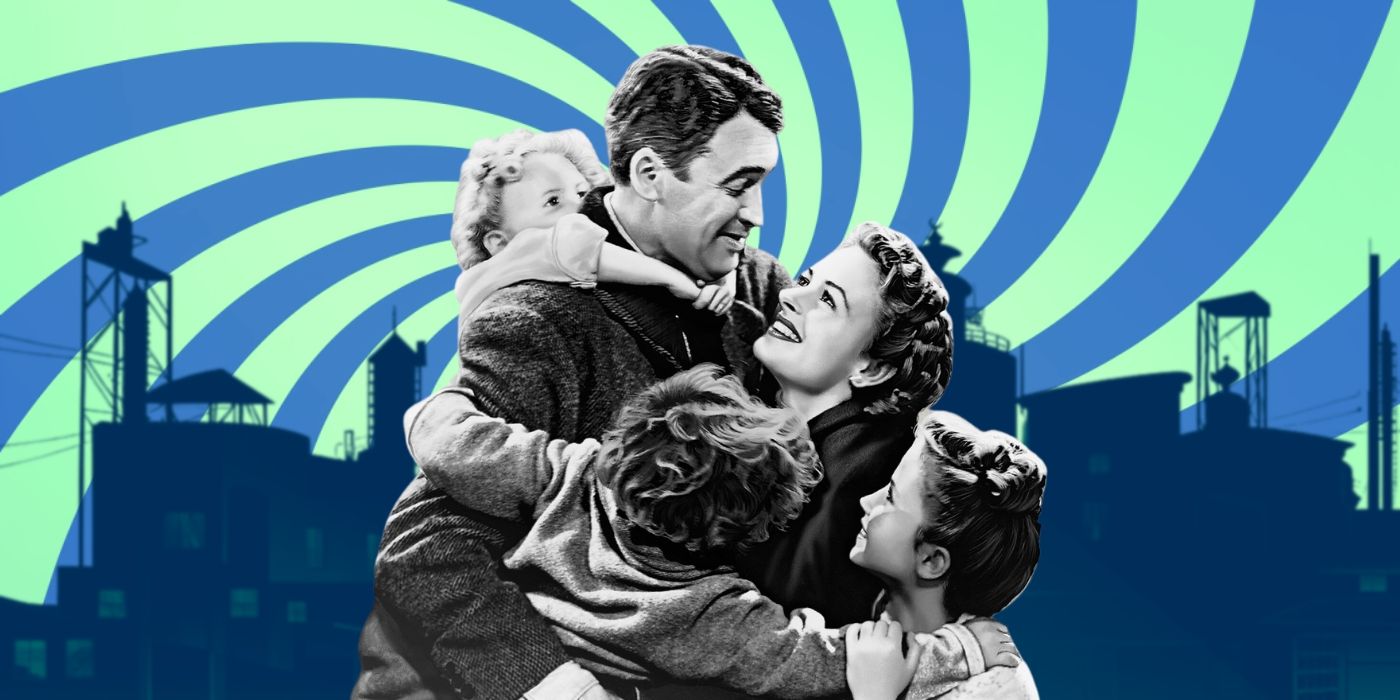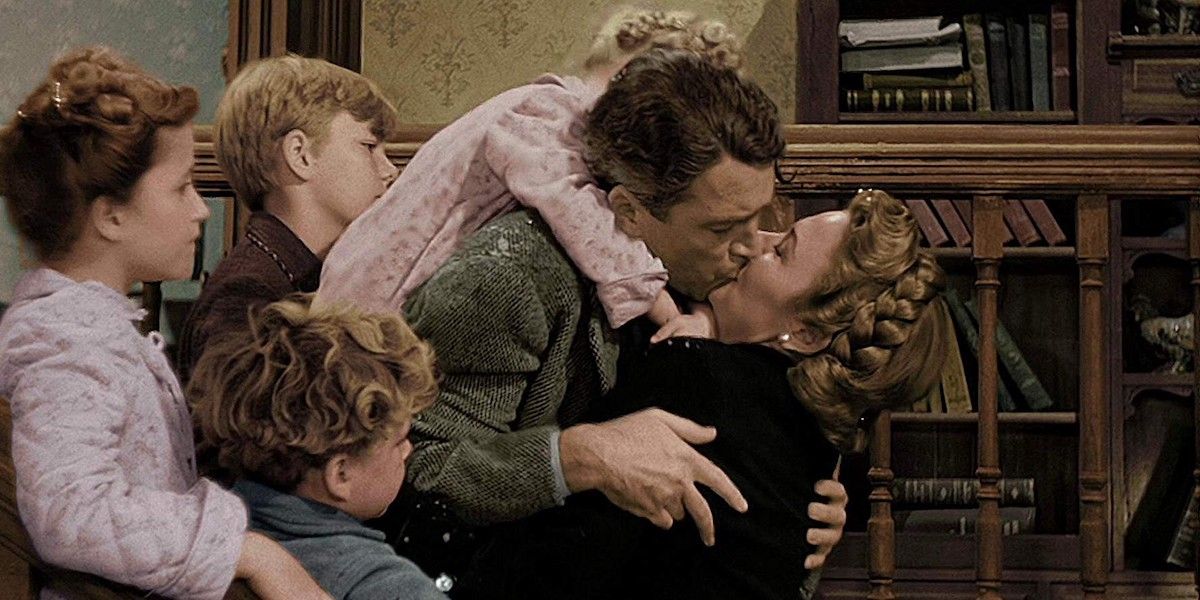The Big Picture
- It's a Wonderful Life explores the destructive forces of capitalism and the constant dashing of dreams.
- The film showcases the struggles of an everyman character who sacrifices his own dreams to ensure the happiness of others.
- Despite its dark and bleak moments, the film ultimately delivers a message of hope and the importance of selflessness.
It’s a Wonderful Life is a ubiquitous Christmas classic, a timeless piece of heartwarming, holiday-centered filmmaking that’s beloved by families to this day since its original 1946 release. What keeps the beloved Frank Capra/Jimmy Stewart feature on the hearts and minds of so many? Probably its magical realist conceit, able to strike directly into the purpose of human existence and remind everyone that they’re special for who they are. Nice and lovely, right? Well, to get there, we have to wade through the unrelentingly destructive forces of capitalism, the constant dashing of dreams, the looming doom of being stuck, the reminder that all people around you get to succeed while you do not, the slide into borderline abusive behaviors of desperation and anger, and eventually, the consideration of suicide. Um… Merry Christmas?
If you’ve not seen It’s a Wonderful Life, or if it’s been a few Christmases since you’ve revisited, I am here to remind you of the film’s massive, non-stop, full-sprint submergence into darkness. Stewart is an everyman actor known for basic tenets of goodness and decency; Capra is a director known for wide-eyed optimism and deification of "good old American values," often seen in a semi-denigrating fashion; both of these broad generalizations do make themselves present in It's a Wonderful Life, but they take their sweet time to get there. For the majority of the film — I’d say a good 3/4ths of its running time, if not a little longer — we watch Capra render his work in unsparing, naturalistic, shadowy-photographed scenes of domestic self-destruction, and we watch Stewart plead, work, and bluster his way through all of his conflicting impulses and responsibilities until he can no longer carry them without breaking. It’s a Wonderful Life does make good on arguing the premise of its title, but it shows us how much courage, grit, and heart is necessary to come to that conclusion.

Its a Wonderful Life
An angel is sent from Heaven to help a desperately frustrated businessman by showing him what life would have been like if he had never existed.
- Release Date
- December 20, 1946
- Director
- Frank Capra
- Cast
- James Stewart , Donna Reed , Lionel Barrymore , Thomas Mitchell , Henry Travers , Beulah Bondi
- Runtime
- 130
- Main Genre
- Drama
- Writers
- Frances Goodrich , Albert Hackett , Frank Capra , Jo Swerling , Philip Van Doren Stern , Michael Wilson
- Tagline
- It's a wonderful laugh! It's a wonderful love!
How Does 'It's a Wonderful Life' Depict Capitalism?
From the beginning of It's a Wonderful Life, we know two true things about Stewart's character of George Bailey, first seen as a child played by Bobby Anderson. He wants, more than anything, to leave his hometown of Bedford Falls, New York for a life of travel, of ambition, of newness. And, he is constantly sacrificing this dream — nay, the basic tenets of his humanity — to ensure the people around him can fulfill theirs instead. A defining moment for George comes during childhood when he saves his brother Harry (Georgie Nokes as a child; Todd Karns grown up) from drowning in an ice-covered pond. Harry is thus blessed to live, travel, and become a decorated war hero. George, however, is cursed with a deafened ear from this act of heroism and suffers the first of many movements and moments eager to keep him frozen in this Bedford Falls pond forever, as everyone around him gets saved and walks away. Capra broadly paints this era of American life with a sense of frank misery — which we most notably see when young George must deal with his employer's inability to process his son's death — but keeps much of the focus zeroed-in on George, or at least magnifies the effect of this casually difficult life on him. "I couldn’t face being cooped up the rest of my life in a shabby little office," insists George. "I have dreams!" Everyone else seems to be able to exist in this world, warts and all, but George can’t help but swing a lasso to the moon, earning nothing but a rope burn as his reward.
This crunching of desire is exacerbated by the crunching of financial numbers, the shadows and facts of capitalism ever-present on everyone’s mind, eager to define one’s status, to decide how valuable they are as human beings. Capitalism as a demon is most explicitly personified by Mr. Potter, a greedy businessman played deliciously by Lionel Barrymore. He wants to own every part of Bedford Falls, even (especially?) if that means owning and devastating any human along the way (“Times are bad, Mr. Potter. A lot of these people are out of work,” pleads George to him at one point. His response, simply: “Well, then, foreclose”). George’s need to unshackle himself from the chains of capitalism dovetails with his need to escape the town in the form of the Bailey Brothers Building and Loan, the family business that does its best to provide the town with a semblance of financial security. George does not want to spend the rest of his life cooped up in this office, staying ahead of Mr. Potter’s unscrupulous temptations of wealth one dollar at a time, but he also seems hardwired to help those around him no matter the literal cost, the ongoing manifestations of his “original helping sin” by saving his brother. At one point, the entire town piles into the Building and Loan desperate for cash; George dutifully finds the money, even if it means taking bills from his own pocket.
It's a Wonderful Life is full of dissections and examples of selflessness and selfishness, how one human action ripples down and affects their neighbor, and how we’re supposed to cope with that when it seems to hurt us at every turn. George Bailey, simply, cannot cope with it, culminating in a stretch of cinema among the most bleak I’ll ever see. He comes home from a fraught meeting with Mr. Potter, who has informed him the Building and Loan will fall under Potter’s control without an impossible amount of money deposited. And he falls apart in front of, and borderline abuses, his family. He screams at his daughter (Carol Coombs) for playing a Christmas song on the piano. He berates his son (Larry Simms) for asking him the definitions of words. Most distressingly, he screams at and even grabs and shakes his beloved wife Mary (the incomparable Donna Reed), Stewart committing wholeheartedly to these venomously unlikeable descents into violence and madness. Guilt-stricken, heartbroken, and at the end of his rope, George flees his home and takes the cynical advice of Mr. Potter. “You’re worth more dead than alive,” told Potter to George. So George, tired of giving himself up, tired of burdening and hurting others, tired of how much money and dead dreams rule the fucking world, stares down the barrel of a bridge and prepares himself to jump.
'It's a Wonderful Life' (Finally) Rewards Us With Christmas Cheer
And then, with barely any time left in the picture, we finally get to the structure of It’s a Wonderful Life that everyone cheerfully mimics when they parody it. Guardian-angel-in-training Clarence, a heartfelt and genuine Henry Travers, makes himself visible to George. And he shows George what life would be like if George had never been born. Thank God! We can finally get George to realize he’s important and loved and worthwhile with a sprint of joy to the end, right? Wrong! Beyond the baked-in malaise to Clarence’s story (he’s introduced being made fun of by his fellow angels, and wants more than anything to finally get his wings), George’s journey through the alternate, George-less dimension is just as upsetting, if not more so, than any moment before. Capra and DPs Joseph Walker and Joseph Biroc bathe these sequences in chiaroscuro shadow (looking beautiful in that 4K restoration), hearkening to the postwar noir tones popular in American cinema of this era. Every single destiny George and Clarence happen upon is worse than the one before, with Potter having decimated the town, Mary having devolved into a life of agoraphobic solitude, and his war hero brother Harry died in that frozen pond so many years ago. As miserable as we saw George before, he’s even more miserable now. “I want to live!” he pleads, doing a complete 180 from his original vantage point. “Please, God, let me live again!” The only thing worse than believing you don’t matter is knowing you do, and being unable to do anything about it.
And wow, does this sequence prove that point and then some. As Clarence allows George to reemerge from this fever dream, It's a Wonderful Life mercifully ends with the blast of Christmas cheer we’ve all seen countless times in packaged pieces of “Christmas cheer” content. George Bailey running down the street screaming “Merry Christmas” at every building; The entire town cramped into his living room singing Christmas songs brightly; Zuzu (Karolyn Grimes) chirping that “every time a bell rings, an angel gets its wings.” These moments make me cry like clockwork, so rife and brimming with emotion, with catharsis, with fucking relief they are. And when you see them, experience them as the finish line to a race full of struggle, chaos, and heartbreak, it washes over you without any sense of saccharine manipulation. George Bailey and his family have a wonderful life, and so do you. It’s our darkest moments that make these most wonderful moments shine the brightest.
It's a Wonderful Life is streaming on Amazon Prime Video in the U.S.


